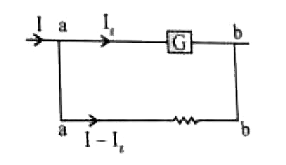A galvanometer having a resistance of 8 ohm is shunted by a wire of resistance 2 ohm . If the total current is 1 amp , the part of it passing through the shunt will be
0.25 A
0.8 A
0.2 A
0.5 A
The correct Answer is:B
The potential difference
Vsh=(Vs−Vh) is the same for the path
IgG=(I−Ig)S
Ig(G+S)=IS
IgI=SG+S

The fraction of current passing through shunt
=I−IgI
=I=IgI=I−SS+G=GS+G=82+8=0.8 A
टॉपर्स ने हल किए ये सवाल
- MOVING CHARGES AND MAGNETISM BOOK - PHYSICS WALLAHCHAPTER - MOVING CHARGES AND MAGNETISM EXERCISE - LEVEL - 2
30 Videos
- MOVING CHARGES AND MAGNETISM BOOK - PHYSICS WALLAHCHAPTER - MOVING CHARGES AND MAGNETISM EXERCISE - NEET PAST 5 YEARS QUESTIONS
12 Videos
- MOTION IN A STRAIGHT LINEBOOK - PHYSICS WALLAHCHAPTER - MOTION IN A STRAIGHT LINEEXERCISE - NEET Past 5 Years Questions
5 Videos
- OSCILLATIONS BOOK - PHYSICS WALLAHCHAPTER - OSCILLATIONS EXERCISE - NEET PAST 5 YEARS QUESTIONS
5 Videos
समान प्रश्न
A wire of length Lmetre , carrying a current Iampere is bent in the form of a circle . The magnitude of its magnetic moment is …………. MKSunits .
View SolutionA long solenoid of 50 cm length having 100 turns carries a current of 2.5A. The magnetic field at centre of solenoid is:
View SolutionA toy car with charge q moves on a frictionless horizontal plane surface under the influence of a uniform electric field →E. Due to the force q→E, its velocity increases from 0 to 6m/s in one second duration. At that instant the direction of field is reversed.
The car continues to move for two more seconds under the influence of this field. The average velocity and the average speed of the toy car between 0 to 3 seconds are respectively.
View SolutionThe phase difference between displacement and acceleration of a particle in a simple harmonic motion is:
View SolutionIf a shunt is to be applied to a galvanometer of resistance 50Ω so that only 5% of total current passes through the galvanometer. The resistance of shunt should be
View SolutionA galvanometer having a resistance of 8 ohm is shunted by a wire of resistance 2 ohm . If the total current is 1 amp , the part of it passing through the shunt will be
View SolutionIn an ammeter 10% of main current is passing through the galvanometer. If the resistance of the galvanometer is G, then the shunt resistance, in ohms is
View SolutionA galvanometer of resistance 98 ohms is shunted by a resistance of 2 ohms. The fraction of the total current that pass through is.
View SolutionA galvanometer having a resistance of18Ωis shunted by a wire of resistance 2Ω. If the total current to be passed is 2A, then the part of it passing through the shunt will be
View SolutionIn an ammeter 10% of main current is passing through the galvanometer. If the resistance of the galvanometer is G, then the shunt resistance, in ohms is
View SolutionA galvanometer of resistance 150 ohm is shunted such that only 1/11 of the main current flows through the galvanometer. The resistance of the shunt is, (in ohm)
View SolutionIf 10% of the main current is to the passed through the moving coil galvanometer of resistance 99 ohm, then the required shunt resistance will be :
View SolutionA galvanometer of resistance 8 Omega . is shunted with 2 Omega resistance. If total current is 1 A, then what will be the shunt current?
View SolutionThe current through a Galvanometer reduces to 20% of its original value when a shunt is connected. The resistance of the galvanometer coil is 100 Ohm. Then the value of the shunt in Ohms is
View SolutionThe current through a galvanometer reduces to 25% of its orginal value when a shunt is connected. The resistance of the shunt is 25 ohm. Find the resistance of the galvanometer.
View Solution

